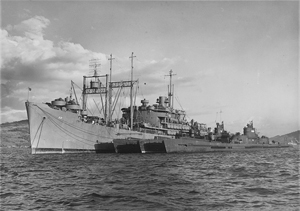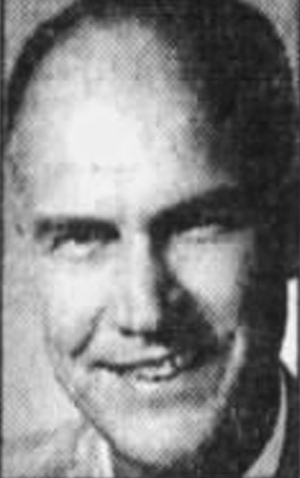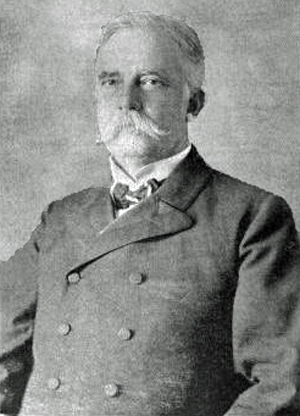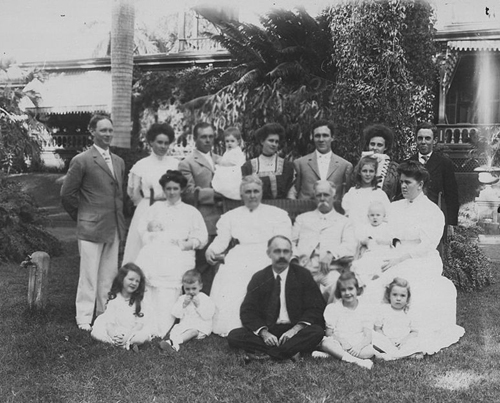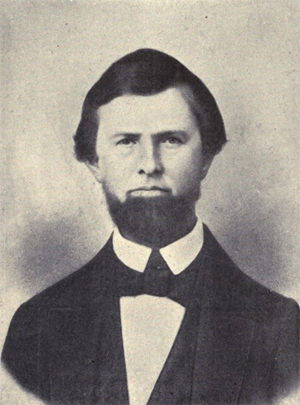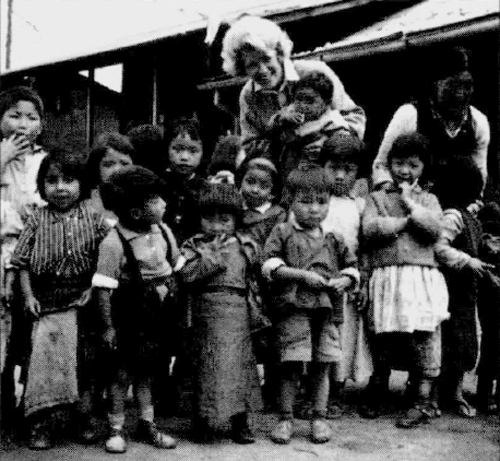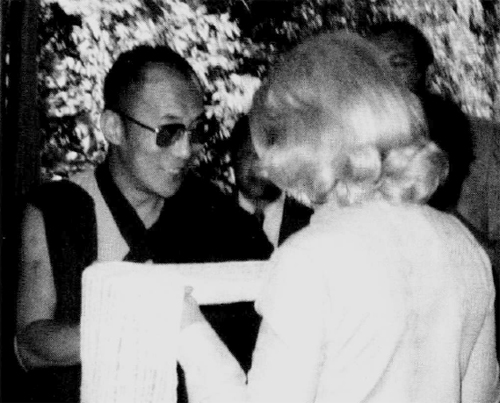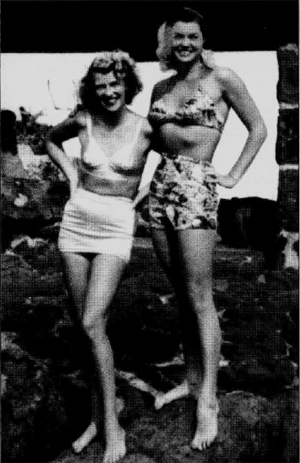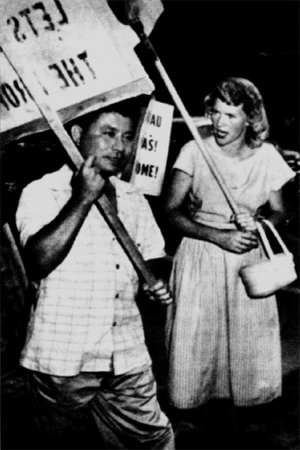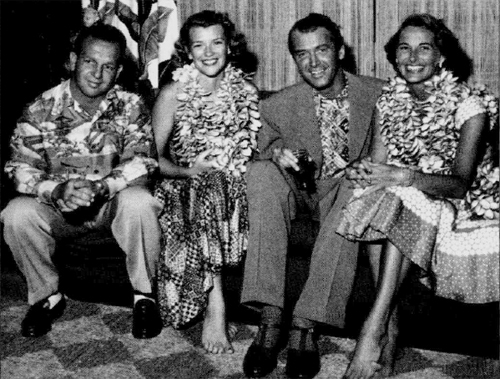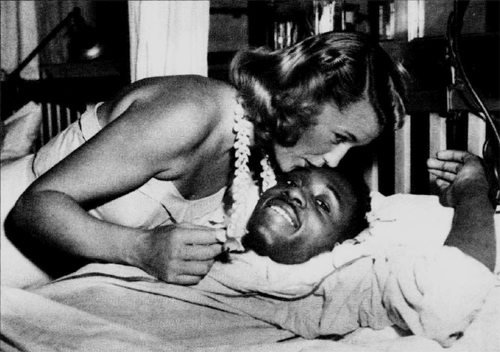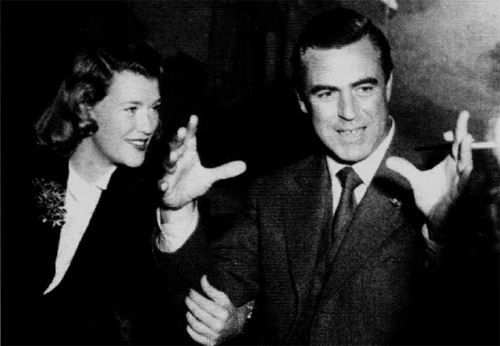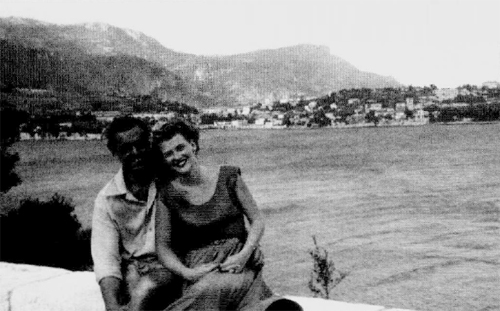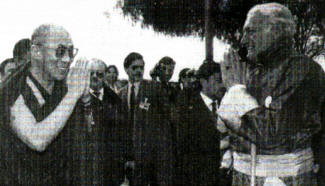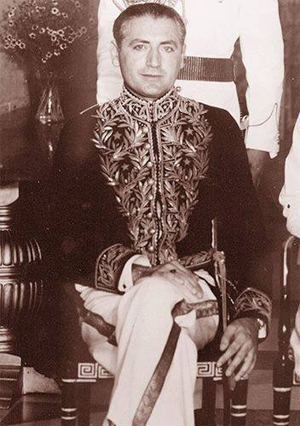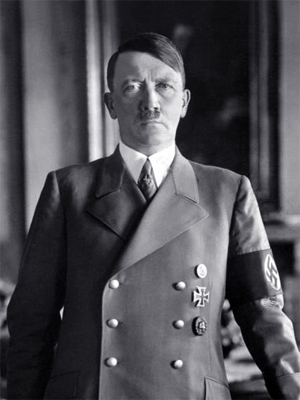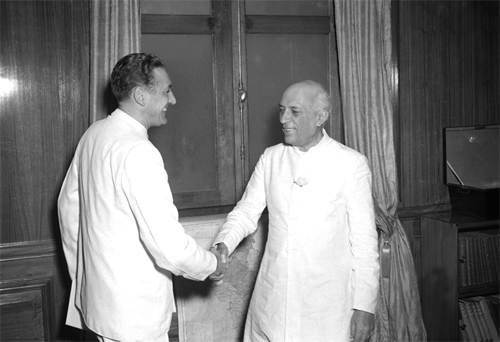by Wikipedia
Accessed: 6/9/20
In 1970, Shankar Bajpai wrote, suggesting we visit him in Gangtok, Sikkim. He had been the Indian Consul General in San Francisco in the '60s, and we'd met through B.K. Nehru. Now he was the Political Officer of Sikkim, which meant he ran the place, as India provided the small mountain country with its foreign policy, currency, and military presence... His letter was provocative, "Two hours from Gangtok there is an exotic monastery in Rumtek. The top boy is a very important Tibetan Lama. Rik will get dramatic pictures and you can have the thrill of knowing another saint."
He loved to kid me about my holy friends.
We decided to do it and put a group of friends together. Taking people to India was turning out to be a new hobby for me. Shankar and his wife, Meera, were delighted. He wrote again, "Before you leave Darjeeling, call me. It's always a frightful bore at the border. Just to be on the safe side, I'll have my men waiting for you. And by the way, do you suppose you could bring me about 12 pounds of fresh pork? If so, we'll have an authentic Tibetan dinner for you."...
As we approached the official residence, we saw the Bajpais sitting in lawn furniture in front of the government house, having tea. Shankar's round face broke into a wide smile as he welcomed us to Gangtok in his flawless English. Light reflected off his baldpate; he looked like a Buddha in his warm, monk-like robe. Meera had a woolen shawl around her sari. The mountain air was cool.
"Come join us. I'm sure you're all ready for a good hot cup of tea."...
Starting out for Rumtek monastery, we were bundled in our coats as we bounced along in our Land Rovers. An hour later, coats were discarded. It had become a lovely, sunny day in the mountains. There was no way to alert the monks that we were coming; we'd just arrive, all 18 of us....
There was the monastery-bright red, glistening in the sun. On both sides were rows of prayer flag trees, similar to those I'd seen at Govinda's in Almora on my first visit to India. Behind the monastery, providing a silent frame, were more mountains. My friends were filled with excitement; none had been to a Tibetan monastery.
As we drove to the entrance, the round wooden door, divided in the middle, stood open in welcome. Three burgundy-robed monks stood by to receive us. A high-cheek-boned Tibetan introduced himself.
"My name is Tashi. We are most happy to welcome you. It is very auspicious. You have arrived just in time for the Black Hat Ceremony. This event takes place once a month at the time of the full moon." We thought it a coincidence; the monks thought otherwise....
We were led up a worn and uneven wooden staircase to a spacious, high-ceilinged room at the top of the monastery. Both ends of the room were opened to the temple below. We had no sooner seated ourselves on the floor than the ceremony began. We had arrived at curtain time.
Darkly clad monks slowly paraded in with long copper horns, at least eight feet in length. Standing to the side of a high, throne-like chair and platform, they blew long, discordant, sonorous notes. Soon another group arrived, escorting to the seat of honor a stocky young man, who wore a high-peaked, brocaded lama's hat. Adjusting his heavy, gold-embroidered cape, he beamed happiness down upon us. He nodded his head to the monks to proceed....
An elaborate brocade box was carried in with much fanfare and presented to the God-King. After opening the box and putting the stiff, black, onion-shaped hat on his head, the Karmapa, with one hand holding the hat in place, closed his eyes in meditation. It was signaled that we follow suit. With my eyes shut I thought to myself, a God-King-how impressive for my friends. Shankar doesn't know this. How lucky we are to be here! Later, as we were each introduced to His Holiness, we presented white prayer scarves, khatas, which Shankar had advised us to take along....
After the Karmapa left, Tashi asked us, "Would you like to meet our sister?" We, of course, said yes and followed him along an outside ledge to a corner room. It was a breathtaking view as we looked down into the valley over the winding road we had followed. All we could see were brown mountains in every directions.
"You must come back again later, when the mountains are green." Following Tashi through a narrow frame door, I stepped into a small hall; to the left a larger room opened out. As I entered, I gasped in surprise. On a low platform sat an English woman in monk's robes. She appeared to be in her sixties and her large, pale blue eyes looked enormous because of her shaved head.
"Come in, I am Sister Palmo. It is a joy to welcome you."...
"What good fortune, coming here on this particular day. It was not accidental; every movement of even a grain of sand is planned." She gently explained some of the basic Buddhist beliefs and traditions to us.....
While the group had tea in another room and ate the picnic sandwiches we'd brought, we made our plans with the English nun.
"Yes, yes, do come back. I knew you would want to. We are meant to become friends. If you would be so kind as to bring me a few things from the Gangtok marketplace, I would be so happy. Then you can have lunch here with me."...
That evening, we celebrated with a Tibetan dinner. The table was heaped with all sorts of succulent, hotly spiced vegetable and pork dishes. The Bajpais had outdone themselves, and they seemed proud of us as a group. We came from Argentina, Washington D.C., New York, Beverly Hills, Honolulu, and Hamburg. Included were top social names, a former U.S. Ambassador, a famous choreographer (Tony Duquette), the head of the Beverly Hills Testavant Chevalier (elite gourmet Society) and a woman astrologer, the grandniece of the legendary flying ace of World War II, Baron Manfred Von Richthofen (the Red Baron). Yes, we were an interesting assortment. We, in turn, were honored to meet the Chogyal with his American wife, Hope Cooke, and the General who had accompanied the Dalai Lama on his escape from Lhasa....
Our group left us early the next morning. Shortly afterward, I initiated Meera Bajpai into TM....
By 8 A.M., the marketplace was open. Vegetables, eggs, spices, and all sorts of foodstuffs were spread out on canvasses in front of flimsy stalls. We laughed as we watched one owner beat a cow on the head as he tried to retrieve a bunch of carrots from its mouth....
Soon we had our baskets filled with bread (a luxury in Rumtek), tomatoes, butter, cream, and all the requested vegetables and fruits. It was time for our return to the monastery....
It was about 11 A.M. when we drove up to the monastery door, giving us at least eight hours of daylight for a nice long visit.
Anila, Sister Palmo's tiny attendant, took our parcels from us with joy and the quick, silent movements of a bird. Sister Palmo was sitting, as she had been when we left her the day before.
"Good morning, what a treat to get all those lovely foods. Come sit near me. Are you sure you wouldn't like chairs brought in?" We assured her not.
She told us a bit about herself. She had been married to an Indian whom she had met while both were students at Oxford. They had three grown children. Their photos were beautiful.
"This one, my son Kabir Bedi, is a leading cinema star in Bombay. He's gone through a painful divorce, but is coming out of it. My husband was a businessman, but now has become a Hindu holy man and psychic healer. At present, he is touring Italy. We meet occasionally, when I go to see my children, and are good friends."
We asked how she had become a nun. "For years I followed Gandhi. One day I was attending a conference, and while walking with some friends, a voice from within spoke to me. It gave me instructions about what I was to do -- I was to renounce the world of activity and become a nun in a Buddhist monastery."
Her full face glowed as she remembered. "My husband understood. He had felt the tug himself. It was a natural, happy parting, and we now travel different roads to the same destination."...
We felt honored as she shared these intimacies with us. Then, abruptly, she changed the subject. "But tell me more about yourselves. What brought you here? How much do you know about Buddhism?"
I spoke first, "Well, I know that the Vedas inspired Gautama Buddha's 'seek out your own salvation,' but that he rejected the Brahmin's interpretation. Born as an Indian prince, he was horrified by what he saw outside the walls of his princely home. Needing to think, to rationalize the 'whys of creation,' he spent hours under the Bodhi tree contemplating. Occasionally he would slip into 'nothingness.' There he was free, free of worries, desires, and emotions. There he experienced total release. Austerities didn't do it, worship didn't do it; contemplation and meditation did it. It brought about the nothingness -- Nirvana!"
"Very good, that's all correct! Buddhism as explained by our Kagyu lineage also states that meditation, while unmasking our deceptions, helps us to know ourselves in the present situation, to face life, and to accept ourselves. It will bring transcendental common sense."...
She continued, "And from Buddha's illuminations, where he transcended the limitations of individuality, he replaced the idea of the immutable, eternal soul incapable of growth and development, with the conception of a spiritual consciousness yearning for freedom and enlightenment through the continuous process of becoming and dissolving." She spoke slowly and clearly.
"Those are almost Lama Govinda's words," I exclaimed.
"Yes, he will be known to the West as the first interpreter of Tibetan Buddhism into layman's terms. He helps one understand how we must abandon our thought habits in order to know the real nature of the Mind that encompasses both the individual and the Universe."...
"But, Sister Palmo, what we don't understand is this: Gautama Buddha was against gods, priests, worship, and dogma. He advised against building monasteries, as did the sages of the Upanishads, warning that, through the problems arising from household responsibilities and positions, jealousies would be born and infighting would develop between superiors and inferiors. All that was important was pure thought. Yet, when he died, they turned him into a god to worship."
"Not exactly -- he's worshipped as Buddha, the Enlightened One, not as a god."...
"Man feels more secure in clinging to traditions. He needs sets of commentaries, and philosophical principles that he can classify and put down in sacred texts -- man clings to 'things.' He wants to possess and make his knowledge exclusive. Even the Karmapa once admitted to me, 'It took the Red Chinese to force Tibet into sharing its wisdom with the outside world.' That was our bad karma, trying to keep it to ourselves."...
Soon it was time for lunch. Rik and I were hesitant to eat at the monastery, where sanitary conditions were uncertain, so we said we'd had a large breakfast. "Not at all, that was hours ago," insisted the nun. "Anila is cooking our meal in the next room. I have taught her to make crepes."
We couldn't believe it; I watched her cook over a little oil burner in the corner. Everything was spotless. The crepes, when served with cream and honey whipped with butter, were delicious....
"What a treat for me," said Sister Palmo. "Our diet is sparse here. One of the things I miss is toast with my tea. We often go weeks without bread. We raise chickens and goats outside the monastery. So it's an eggs, goat's milk, and grain menu."...
Sister Palmo was interested in hearing about Maharishi and his teachings. "He sounds like a wise man, and from the happiness you both exude, one can see it's working."...
She explained in detail her daily routine, how she counted hundreds of thousands of Aum mani padme hum, a Buddhist mantra, on her rosary-type beads, her mala. She told us about visualization, very important in the practice of Buddhism, and the exaltation one felt when the Buddha was seen sitting on a lotus with the honey of compassion dripping down....
Shortly after lunch, she announced, "Anila has brought a message that His Holiness is ready to receive you."...
The room was bare, but lighted by many windows. On a small divan-like platform sat His Holiness. Without his hat and heavy cape, he looked younger than he had the day before. Now, he wore a simple wine-red robe. He smiled in welcome, indicating we should sit on cushions near him.
Then we had a surprise. A beautiful Indian woman entered the room. It was Goodie Oberoi. Sister Palmo was delighted to find we knew each other, and left us with Goodie to interpret. "How is it that you are here?" I asked. She had been one of the Indian friends I'd brought to Maharishi for initiation while I was attending the 1969 course in Kashmir. She hadn't mentioned the Karmapa to me.
"His Holiness is my treasured teacher now and has helped me more than anyone in the world." I could understand her need of help. Her life with Bikki, son of the hotel tycoon, had to be difficult. Bikki's love of drinking and women were well-known among the social set of India.
"Sister comes to visit us and now we have one of her nuns with us at home. You have no idea, Nancy, what a wonderful change it has brought over the children. I will always love Maharishi," she continued, "but, for me, I need personal contact with my spiritual guide." Her handsome face looked more serene than I had ever seen it....
"This is a most wonderful soul," Goodie explained. "You are fortunate to see him like this and share his darshan. He is revered as a God King by the Sikkimese, Bhutanese, and many Tibetans. He is the Supreme head of the Kagyu Order of Tibetan Buddhism, the embodiment of the power and compassion of Buddhist Tantra. They consider him a higher incarnation than the Dalai Lama. When the Chinese invaded Tibet, India offered the Dalai Lama asylum; likewise the Karmapa, but he came here to Sikkim at the invitation of the Chogyal."
The Karmapa radiated sunshine and he was attentive when we spoke. He appeared to be in his 30s, but I heard later he was almost 50. "He would like to give you a special mantra," Goodie explained. It was an honor we couldn't refuse. We moved close to him. He had been knotting some cords while he spoke and with his expressive hands he now tied both a yellow and red cord around each of our necks. With a small pair of scissors, he cut a lock of hair from our heads.
"It is a great blessing," Goodie explained, "that he would knot the cords and put them around your necks with his own hands. It is unusual, and I'm so happy for you. You have taken refuge in the Buddha with this ceremony."
She wrote down our mantras on a piece of paper, handing it to us with some powder and pills. "Sister Palmo will explain these to you."
The good Sister was overjoyed when she heard what had transpired and clapped her hands. "When you walked into my room today and my thangka of Vajrasattva was exposed, I knew something auspicious would happen. Usually we keep that particular thangka covered."
We told her about the mantras, and she understood our dilemma. "You are right. Stick to what you are doing. But, sometimes on a special full moon, or in a time of danger, you might use them."
She explained the healing qualities of the powder and pills to which I reacted, "Oh, good, I'll take them to my husband." She agreed they might help. (Unfortunately, Tony never saw any apparent effects.)...
Again the day came to an end, far too quickly. Sister Palmo escorted us to the jeep. "We will keep in touch through letters, and one day I will come to see you in the U.S. You will come back to Rumtek. It is written." In fact, the following year she stayed with us in Beverly Hills and made a lasting impression on my family. I felt my children were fortunate to meet such dedicated people....
My encounters with the world of Buddhism started with Lama Govinda, followed by the Dalai Lama, and now continued with the Karmapa. The more I was exposed to their spiritual leaders, the more attracted I became. There was no doubt that I felt a kindred spirit for the Tibetan race. They are bright, outgoing, and friendly in spite of the terrible hardships their people and homeland have suffered; they are optimistic and determined to succeed. Maybe I had been a Tibetan in one of my past lives.
-- Chapter 23. Politicians versus Saints. Excerpt from "All You Need is Love: An Eyewitness Account of When Spirituality Spread from the East to the West", by Nancy Cooke de Herrera
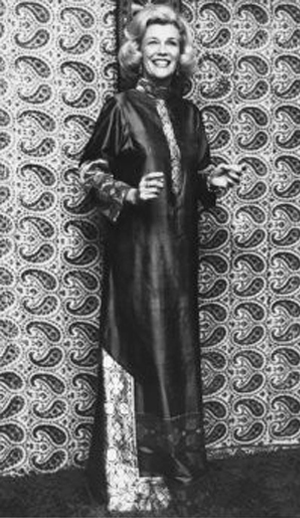
Nancy Cooke de Herrera
Born: Nancy L. Veitch, April 12, 1922[1][2], Alameda County, California[1] [daughter of Edward Irving Veitch and Marie Beatrice Morledge]
Died: February 28, 2013 (aged 90), Beverly Hills, California[3]
Occupation: Socialite author
Spouse(s): Richard [Alexander] Cooke, [Jr.] (1941), Luis de Herrera (1951), Tony Jackson [Morton Barrows Jackson] (1962)
Children: One daughter, three sons
Nancy Cooke de Herrera (born Nancy Veitch, 1922–2013)[2] was an American socialite, fashion expert, and author of three books, including All You Need Is Love: An Eyewitness Account of When Spirituality Spread from the East to the West.[4][5] She was referred to as one of the pioneers of the spiritual movement in the West.
Early life and education
De Herrera grew up in Piedmont, California and studied bacteriology at Stanford University for three years during the 1940s (Class of '43).[6][7]
Adult life
De Herrera traveled to Molokai in Hawaii via a military convoy...
Name: Hawaiian Merchant; USS Euryale (AS-22)
Namesake: Euryale
Builder: Federal Shipbuilding and Drydock Company
Launched: 12 April 1941
Sponsored by: Mrs. Richard A. Cooke
Acquired: purchased by Navy 15 April 1943
Commissioned: 2 December 1943
Decommissioned: 7 October 1946
USS Euryale (AS-22) was built as the Hawaiian Merchant by the Federal Shipbuilding and Drydock Company in Kearny, New Jersey for the Matson Navigation Company. Hawaiian Merchant was launched 12 April 1941, minutes after sister ship Hawaiian Shipper, and was completed April 1941. Matson intended the ship to join Hawaiian Planter and Hawaiian Shipper in the U.S. Pacific Coast—Australia route. The ship was under United States Army Transportation Corps charter when the United States went to war and came under the control of the War Shipping Administration which allocated the ship to the Army's continued charter until the ship was purchased 15 April 1943 by the United States Navy and commissioned 2 December 1943 as USS Euryale (AS-22), serving as a submarine tender through the war. Euryale was decommissioned 7 October 1946, going into reserve until 9 August 1972 when she was delivered to the Maritime Administration with immediate sale to American Ship Dismantler, Inc. for disposal.
-- USS Euryale (AS-22), by Wikipedia
and married Richard [Alexander] Cooke, Jr., the son of a well-known missionary family in 1941.[7][8]
Richard Alexander Cooke, one of the founders of La Pietra Hawaii School for Girls, died Wednesday in San Mateo, Calif. He was 84.
Along with his second wife, Lorraine, he helped found the all-girls school in the early 1960s. Richard Cooke also helped secure the Dillingham Estate for the school's campus on the slopes of Diamond Head.
Cooke worked for C. Brewer & Co. for 27 years before leaving to run for political office and found his own company, Richard Cooke Developments Inc., which later became Richard Cooke Construction and Pole Houses of Hawaii. He also was president of the Cooke Foundation Ltd.
Cooke was the great-grandson of missionary Amos Starr Cooke.
While at Yale University in the 1930s, he qualified for the Olympic swim team. He served in the Navy during World War II.
A world traveler with an artistic bent, Cooke had a life-long interest in sculpting and published a 1964 book on his travels, "Once Around Lightly."
He is survived by his wife, Vivienne; children, Richard III [Richard Cooke III, "Rik"], Starr, Brett, Marcia Duff, Brian Farquharson and Cynthia de Moucheron; and sisters Patricia Peacock and Dagmar Heglund.
A service will be held at 4 p.m. Tuesday at Kawaiahao Church. In lieu of flowers, the family asks donations to La Pietra Hawaii School for Girls, the Moloka'i Community Services Council or Mission Houses Museum.
-- Death of Richard Alexander Cooke, age 84, 13 Jan. 1999; Richard A. Cooke, 84, La Pietra founder, by Advertiser Staff
As the wife of a prominent family member, she performed hostess duties for Admiral Nimitz, Admiral Halsey, and Admiral Towers during World War II. She gave birth to three sons and divorced her husband after nine years of marriage.
While in Paris in 1951, she met a member of the American team that raced at Le Mans, named Luis de Herrera, whom she married a year later. The couple moved to Herrera's home country of Argentina and had a daughter in 1954.[7] Nine months later her husband, Luis, died of leukemia which Cooke de Herrera believed was related to atomic radiation exposure he incurred while driving near Zion National Park after an atomic bomb test in 1953.[4][6][7][9]
In 1957, de Herrera won a nationwide contest sponsored by a group of American (USA) magazines. Her prize was a world tour to promote American fashion. Afterwards, the United States Information Service (USIS) enabled her to visit governments around the world and advise them on fashion.[10] For twelve years she was a leading figure in the fashion industry and was referred to as the "U.S. Ambassadress of Fashion" while traveling to 15 countries to present American couture.[4][6][9] She also presented lectures entitled: "A Travelogue through Fashion" and "Around the World with Nancy Cooke".[11]
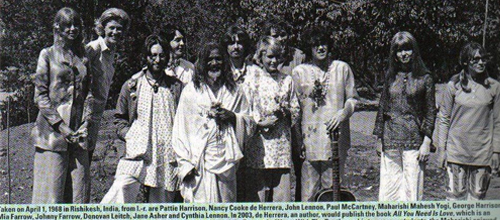
De Herrera worked as a publicist for Maharishi Mahesh Yogi in the 1960s and traveled with him on a trip to South America.[7][12] She was the liaison for the Maharishi and The Beatles during their widely publicized visit to Rishikesh in India.[6] During her dozens of trips to India and Tibet she is reported to have had meetings with the Dalai Lama, the sixteenth Gyalwa Karmapa, Sir Edmund Hillary, the Shah of Iran, King Hussein of Jordan, and Satya Sai Baba.[6] In 1993, she published the autobiographical memoir, Beyond Gurus: A Woman Of Many Worlds, and in 2003, published a follow-up book called, All You Need Is Love: An Eyewitness Account of When Spirituality Spread from the East to the West.[4]
Over the years she is reported to have given meditation lessons to several celebrities, including Madonna, Greta Garbo, Rosie O'Donnell, Lenny Kravitz, Santigold,[13] and Sheryl Crow.[6][9] She has been called one of the pioneers of the spiritual movement in the West.[14] In 2008, she published the novel, Never Tango with a Stranger: Love in Peron's Argentina.[15] According to de Herrera, with the help of some friends, she built two hospitals for abused children in Los Angeles.[10]
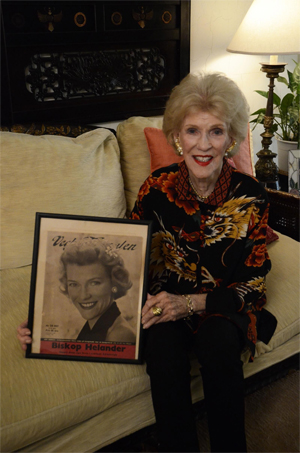
She was reportedly working on a third autobiography, concerning her role as the U.S. Ambassadress of Fashion in the 1950s when she died[12] on February 28, 2013 at the age of 90.[12]
De Herrera and her son Richard Cooke [Richard Cooke III, "Rik"] were the subject of the Beatles' satirical song "The Continuing Story of Bungalow Bill".[16]
"The Continuing Story of Bungalow Bill" is a song written by John Lennon (credited to Lennon–McCartney), and released by the English rock band the Beatles on their 1968 double album The Beatles (also known as the "White Album")....
This song mocks the actions of a young American named Richard A. Cooke III, known as Rik, who was visiting his mother, Nancy Cooke de Herrera, at the ashram of Maharishi Mahesh Yogi in Rishikesh at the same time that the Beatles were staying with the Maharishi. According to his mother, both she and her son maintained friendly relations with all of the Beatles except for Lennon, who by Cooke de Herrera's account was "a genius" but distant and contemptuous of the wealthy American Cooke de Herrera and her clean-cut, college-attending son. According to Nancy's life account, Beyond Gurus, the genesis of the song occurred when she, Rik, and several others, including guides, set out upon elephants to hunt for a tiger (allegedly presented by their Indian guide as a traditional act). The pack of elephants was attacked by a tiger, which was shot by Rik. Rik was initially proud of his quick reaction and posed for a photograph with his prize. However, Rik's reaction to the slaying was mixed, as he has not hunted since. Nancy claims that all present recognised the necessity of Rik's action, but that Lennon's reaction was scornful and sarcastic, asking Rik: "But wouldn't you call that slightly life-destructive?" The song was written by Lennon as mocking what he saw as Rik's bravado and unenlightened attitude.
Lennon later told his version of the story in a Playboy interview, stating that: "'Bungalow Bill' was written about a guy in Maharishi's meditation camp who took a short break to go shoot a few poor tigers, and then came back to commune with God. There used to be a character called Jungle Jim, and I combined him with Buffalo Bill. It's sort of a teenage social-comment song and a bit of a joke." Mia Farrow, who was also at the ashram during the period, supports Lennon's story in her autobiography; she writes, "Then a self-important, middle-aged American woman arrived, moving a mountain of luggage into the brand-new private bungalow next to Maharishi's along with her son, a bland young man named Bill. People fled this newcomer, and no one was sorry when she left the ashram after a short time to go tiger hunting, unaware that their presence had inspired a new Beatles song – 'Bungalow Bill.'"Hey, Bungalow Bill
What did you kill
Bungalow Bill?
Hey, Bungalow Bill
What did you kill
Bungalow Bill?
He went out hunting with his elephant and gun
In case of accidents he always took his mom
He's the all-American bullet-headed Saxon mother's son
All the children sing
Hey, Bungalow Bill
What did you kill
Bungalow Bill?
Hey, Bungalow Bill
What did you kill
Bungalow Bill?
Deep in the jungle where the mighty tiger lies
Bill and his elephants were taken by surprise
So Captain Marvel zapped him right between the eyes
All the children sing
Hey, Bungalow Bill
What did you kill
Bungalow Bill?
Hey, Bungalow Bill
What did you kill
Bungalow Bill?
The children asked him if to kill was not a sin
"Not when he looked so fierce", his mommy butted in
"If looks could kill, it would have been us instead of him".
All the children sing
Hey, Bungalow Bill
What did you kill
Bungalow Bill?
Hey, Bungalow Bill
What did you kill
Bungalow Bill?...
-- The Continuing Story of Bungalow Bill, by Wikipedia
Books
• Cooke de Herrera, Nancy (1993) Beyond gurus : a woman of many worlds, Blue Dolphin Pub.[15]
• Cooke de Herrera, Nancy (2003) All you need is love : an eyewitness account of when spirituality spread from the East to the West, Jodere Group [15]
• Cooke de Herrera, Nancy (2008) Never Tango with a Stranger: Love in Peron's Argentina, iUniverse[15]
References
1. California Birth Index, 1905-1995
2. "Meditation teacher Nancy Cooke de Herrera dies". NewsObserver.com. March 4, 2013.[permanent dead link]
3. Los Angeles Times Obituary, 8 Mar 2013
4. All You Need Is Love: An Eyewitness Account of When Spirituality Spread from the East to the West Archived2011-04-06 at the Wayback Machine All Spirit Fitness, book review, 2003.
5. Cae, Herb. (Aug 31, 1961). Los Angeles Times, "Official State Song Slips Disc: Nancy Cooke de Herrera the beautiful blond socialite".
6. Jalonen, Wendy (May–June 2010), "TM believer", Stanford Magazine (Stanford Alumni website), archived from the original on 2012-06-25, retrieved 2011-04-03
7. Cooke de Herrera, Nancy (1993) Blue Dolphin Publishing, Beyond Gurus: A Woman of Many Worlds, pp27-44
8. Cassidy, Maggie July 29, 2011 A Most Unusual Life, Molokai Dispatch
9. Cassidy, Maggie July 29, 2011 A Most Unusual Life, Molakai Dispatch
10. Misra, Neelesh (Dec 1, 1995) U.S. Author Says That India Still Draws Her, India Abroad
11. Unknown author (2005) Writers Directory 2005, Nancy Cooke de Herrera
12. Baida, Aiyana (March 5, 2013). "Celebrity Meditation Teacher". VOXXI. Archived from the original on May 13, 2013. Retrieved March 26, 2013.
13. Author unknown (April 22, 2012) Santigold NME Music News, retrieved April 30, 2012
14. Author Unknown ALL YOU NEED IS LOVE Archived 2011-04-06 at the Wayback Machine Planet Light Worker web site, Book Review. Retrieved: April 3, 2011
15. Nancy Cooke de Herrera World Cat, retrieved April 30, 2012
16. https://www.quora.com/Who-is-Bungalow-B ... nnington-1
***************************************************
Obituary: Nancy Cooke de Herrera
Nancy Cooke de Herrera April 12, 1922 - February 28, 2013. She was a Piedmont High School alum.
by Analisa Harangozo, Patch Staff
Mar 7, 2013 4:48 pm PT | Updated Mar 7, 2013 9:51 pm PT
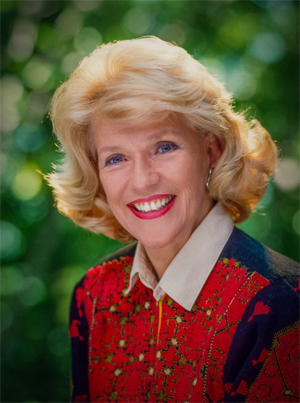
by Brett Cooke
Nancy Cooke de Herrera, an inveterate traveler, began her next journey February 28, 2013, with her children present in Beverly Hills to offer a peaceful farewell. She enjoyed a life sufficiently full to require three autobiographies: All You Need Is Love: An Eyewitness Account of When Spirituality Spread from the East to the West, 2003), Never Tango with a Stranger: Love in Peron's Argentina (2008), and Around the World with Nancy Cooke (in preparation).
Born in Oakland, April 12, 1922, the daughter of Edward Irving Veitch and Marie Beatrice Morledge,...
Registered in 1938 by Edward Irving Veitch, 180 Woodland Way, Piedmont, California, as the 44-ton yacht Hermit, homeported at San Francisco, call sign WOWA. Veitch invented the bobby pins in 1935 and got a patent in 1938. Women who bobbed their hair found it difficult to control the shorter strands with conventional hairpins but Veitch's wavy design held them securely in place. They were made by the Vogue Pin Company in Oakland....
Registered in 1935, by Edward Irving Veitch, 180 Woodland Way, Piedmont, California, as the 67-ton yacht Chiro, homeported at San Francisco.
-- World War II U.S. Navy Vessels in Private Hands: The Boats and Ships Sold and Registered for Commercial and Recreational Purposes Under the American Flag, by Greg H. Williams
Nancy attended Piedmont High School with her lookalike sisters, Ardagh Marie Kistler and Doryce Lorillard Hills Wells, then Stanford University.
In 1942 she married Richard Alexander Cooke, Jr., with whom she raised three sons, Richard Alexander Cooke III, Starr Edward Cooke, and Leighton Brett Cooke, while living in Hawaii. They were divorced in 1951.
Subsequently Nancy married Luis Alberto de Herrera and moved to Buenos Aires, where they bore a daughter, Maria Luisa de Herrera. After Luis' untimely death in 1955, she founded a public relations firm in San Francisco.
Selected in 1956 as the US Ambassadress of Fashion, she travelled the major capitals of the world on tours organized by the United States Information Agency. Later, at the invitation of the Kremlin, Nancy led a delegation of San Francisco businesswomen to the USSR. She toured the United States, lecturing on the fashions and cultures of the world.
In 1962, Nancy visited many of the holy men of India, an experience that changed her life. Upon her return to California she married Morton Barrows Jackson...
To Whom It May Concern:
This is a request under the Freedom of Information Act. I hereby request the following records:
Documents relating to or mentioning Morton Barrows "Tony" Jackson and his contacts and employment with the Agency, including but not limited to those mentioned in https://ia601504.us.archive.org/18/item ... ackson.pdf This includes previous disclosure of his employment by your Agency. His death has been widely and extensively reported. http://articles.latimes.com/1991-12-16/ ... on-jackson
I am a member of the news media and request classification as such. I have previously written featured articles on the Agency, and have a long-term contract to write the Encyclopedia of the OSS. http://andmagazine.com/us/1431865273.html
The requested documents will be made available to the general public, and this request is not being made for commercial purposes.
In the event that there are fees, I would be grateful if you would inform me of the total charges in advance of fulfilling my request. I would prefer the request filled electronically, by e-mail attachment if available or CD-ROM if not.
Thank you in advance for your anticipated cooperation in this matter. I look forward to receiving your response to this request within 20 business days, as the statute requires.
Sincerely,
Michael Best
Time
Luncheon Guests
1:00 p.m.
3 December 1973
888 16th Street, N.W.
The following will be the luncheon guests today:
Hugh Sidey -- Host and Bureau Chief. Always been cordial, friendly and fair as far as I can figure out. He covered Kennedy in 1960; then was White House correspondent and then began writing a column on the Presidency for Life. When it folded, he took the column to Time. He appears on the Agronsky show and you may have met him when he came out with the Time writers for a briefing.
John Stacks -- He is the Washington News editor. He is the second man in the Washington Bureau; an inside desk man, I would think.
Jess Cook -- He was out here at your ONE backgrounder. We get calls from him now and then.
John Steele -- He was out here for the briefing a year or so ago. He is the magazine's senior correspondent. I gather he does corporation business, e.g., the visit of Japanese industrialists under Time, Inc. sponsorship was his baby.
John Mulliken -- He covers the White House and has been out here for a number of briefings and has been appreciative.
Jerry Hannifin -- He is the one who talked to me about the Vietnam torture story and told me that the conduct of the POW's was a reaffirmation of what kept our nation going at Valley Forge, at Cold Harbor, at Vicksburg. Hannifin is the Time man on the Watergate case, according to a memo you wrote concerning his uncovering of the name of Morton Jackson.
Jerry Schecter -- Diplomatic editor in Washington and a long-time friend of Bill Nelson's. Nelson has pressed him a couple of times on the sourcing of the Khruschev memoirs. Bill knows Jerry from their days in Tokyo….
9. FEDERAL BUREAU OF INVESTIGATION INQUIRIES
The Federal Bureau of Investigation has inquired regarding the following additional individuals and activities:
A. William Marihugh
The specific reason for the FBI's interest in Mr. Marihugh was not stated. Mr. Marihugh entered on duty with this Agency on 31 March 1958. He retired under a medical disability as a GS-14 Electronics Engineer on 16 February 1972.
B. Morton Barrows Jackson
Mr. Jackson and Everette Howard Hunt are believed to have been in contact with each other during early 1972. Mr. Jackson listed Mr. Hunt as a Character Reference on his Agency employment application in August 1950.
QUESTION (to Mr. John Warner on 29 November 1972):
Details on Morton Barrows Jackson, who worked about twenty years ago with the Agency.
RESPONSE:
Mr. Morton Barrows Jackson was utilized by the Agency overseas in a covert capacity covering the period from February 1951 to approximately June 1954. He was never a Staff Employee of the Central Intelligence Agency. Although Mr. Jackson is known to have listed Mr. Everette Howard Hunt as a character reference in August 1950, we have no information on the nature or extent of their association. Attached is a memorandum prepared giving full details on the background of Morton Barrows Jackson.
On 19 August 1972 Mr. Jackson called the Agency asking how to respond to possible Grand Jury questions with respect to his connections with the Agency. He was advised to say that there had been an association during the early 1950’s but to try to refer further specific questions to the Agency. On 31 August 1972 he phoned to say he had done so, that no problems had arisen, and that he expressed appreciation.
MORTON BARROWS JACKSON
1. Subject’s name came to the attention of this Agency through the Federal Bureau of Investigation, as a possible contact of Everette Howard Hunt, Jr., on the West Coast during early 1972. (Subject, in August 1950, listed Mr. Hunt as a character reference for covert Agency employment.)
2. Subject was born on 17 July 1921 at Devils Lake, North Dakota. He attended Harvard University from 1938 to 1940 and the University of Southern California from 1946 to 1948. He was admitted to the California Bar in 1949. Subject’s legal experience includes service on the Intergovernmental Committee for European Migration, Geneva, Switzerland, from 1954 to 1957, and as Regional Commissioner of the Immigration and Naturalization Service, Department of Justice, from 1958 to 1959. Subject is a retired lieutenant commander in the U.S. Naval Reserve. He is presently a partner in Jackson, Goodstein, Kumler, Copes, Croskey and Smith, Suite 1651, 1901 Avenue of the Stars, Los Angeles (Century City), California 90067; telephone: (213) 277-0200. The firm engages in general civil and trial practice in all State and Federal Courts.
3. Subject was a covert asset of this Agency in Bangkok, Thailand, from February 1951 until January 1954, which his contract expired. He was associated then with the Intercontinental Engineering Corporation.
4. In February 1954 Subject was considered for an administrative position with an Agency-sponsored Fund in Switzerland. The International Organizations Division cancelled their interest on 2 June 1954. Subject was, during 1954, an occasional source of the Bern, Switzerland, Station, but no formal relationship existed.
MEMORANDUM FOR THE FILES
FROM: PETE KINSEY
SUBJECT: INTERVIEW OF CHARLES COLSON – JAN. 20, 1975
On January 20, 1975, Senators Weicker and Baker and A.B. Culvahouse and myself met with Charles Colson at the U.S. Courthouse in Washington D.C.
As a preliminary matter, Sen. Weicker read back the notes of the interview which he had had with Colson on January 13, 1975. With certain corrections, Colson confirmed their accuracy. Colson indicated that it was Richard Ober – the CIA liaison man to Kissinger – who received packages from Howard Hunt and passed them on to Richard Helms. Colson stated that the impeachment hearings contain certain information related to a “MR. X” and that there is an affidavit stating that Hunt was bringing Ober packages through May of 1972, which were being passed on to Helms (Bill Gill of ABC News believes that the “MR. X” is, in fact, Ober). Colson indicated that although he did not know for sure, he believed the packages passed to Ober may have contained tapes. Colson bases his speculation on two things. The first relates to an NBC interview with Bernard Barker in April of 1972. Barker described being with Hunt during an interview with an individual in Miami who had been with Castro at the time Robert Kennedy was assassinated. Hunt had a tape recorder and when Barker asked Hunt what the tapes were for, Hunt replied that they were for the CIA (Bill Gill said that Hunt replied “taping for the old company”). The second basis for Colson’s speculation related to the time when Hunt met with David Shapiro while trying to see Colson to pass on a request for money. When Shapiro would not let Hunt see…
[LINES OF TEXT MISSING]
Colson mentioned Morton Jackson again and the fact that Hunt had had breakfast with Jackson the morning of the [Dr. Lewis] Fielding break-in and that the Greenspun capes had been planned in Jackson’s home….
Colson discussed certain private firms either owned by the CIA or used by the CIA. These include:
-- Intertel, a private detective firm in Washington owned by Hughes doing work for the CIA
-- Anderson Security Consultants – CIA propriety
-- Morton Jackson’s Law Firm….
***
Page 3755
Senator BAKER. I have a great respect for Director Helms and if he says it was a brown wig, I believe him.
And you have identification papers; you have camera equipment; you have recording equipment; you have the processing of film; you have the making of prints; you have help in the assembling of the cables; you have your contact with General Cushman; you have Mr. Jackson, Mr. Morton Jackson, a former CIA agent whom you went to as your best friend farthest from Washington. The record is simply studded with that sort of thing.
Now, what I am really reaching for, Mr. Hunt, is a pretty important and crucial question, I judge. That is whether or not the CIA, wittingly or unwittingly, officially or unofficially, was in effect a support agency for your operation and others at the White House.
Do you care to characterize that it was or was not, under those circumstances, a support facility, in effect, for your operations?
Mr. HUNT. Well, under – certainly, the initial circumstances; yes, Senator….
***
Page 87
when he was preparing Mr. Hunt for grand jury testimony probably in April or May.
Mr. BUTLER. April or May 1973. All right. Thank you Mr. Bittman. Thank you, Mr. Chairman.
Mr. DONOHUE. Mr. Seiberling.
Mr. SEIBERLING. Thank you, Mr. Chairman. Mr. Bittman, what was the name of the attorney who referred Mr. Hunt to you as a client?
Mr. BITTMAN. Morton Jackson
Mr. SEIBERLING. And he was from Los Angeles?
Mr. BITTMAN. Yes, sir. He’s a personal friend of Mr. Hunt’s, represented him in the capacity as an attorney and as a member of a law firm. I don’t know how big it is out there. I didn’t meet him. I didn’t know him when he called me….
***
EXCERPTS FROM HEARING OF SEPTEMBER 11, 1973
Present: Terry Lenzner, assistant chief counsel; Scott Armstrong, investigator; and H. William Shure, assistant minority counsel; Sidney Sachs, counsel for Mr. Hunt.
Mr. ARMSTRONG. Was Mr. Morton Jackson aware of the nature of your business with Mr. Winte in Los Angeles?
Mr. HUNT. No.
Mr. ARMSTRONG. Or the fact that you had business with Hughes Tool Co.?
Mr. HUNT. No. I had no business with Hughes Tool Co.
Mr. ARMSTRONG. Had you projected business with Hughes Tool Co., that is had you hoped to do business with Hughes Tool Co.?
Mr. HUNT. I do not know that I did. I think that is a premise I would object to.
Mr. ARMSTRONG. Well, consulting with the Hughes Tool Co.?
Mr. HUNT. I would again reject that assumption, Mr. Armstrong.
Mr. SHURE. Do you have any relationship with the Hughes Tool Co.?
Mr. HUNT. I had been introduced to Mr. Winte, who is the chief security officer for the Hughes Tool Co. I had some conversation with him.
***
Page 3690
16.3 E. HOWARD HUNT TESTIMONY, SEPTEMBER 24, 1973, 9 SSC 3690
Mr. DASH. Now, did you hear from Mr. Liddy during this period of time?
Mr. HUNT. What period of time?
Mr. DASH. Shortly after, around June 19 or around that time?
Mr. HUNT. Yes, sir, I did.
Mr. DASH. What, if anything, did he tell you?
Mr. HUNT. Toward midday on the 19th, I got a telephone call from him at my Mullen Co. office saying that he needed urgently to meet me. We met at the corner of the USIA building, which I believe is at 17th and Pennsylvania Ave. We met, walked around the block. During the course of the conversation, he told me that it was necessary for me to get out of town, that “they” wanted me to get out of town.
Mr. DASH. Did he indicate who “they” were?
Mr. HUNT. Not at that time.
Mr. DASH. Then, was it a fact that that particular order was rescinded?
Mr. HUNT. He told me that it was.
Mr. DASH. Now, in fact, you did leave Washington, did you not?
Mr. HUNT. I did.
Mr. DASH. And did you ultimately go to California?
Mr. HUNT. I did.
Mr. DASH. At that time, did you make arrangements to obtain Counsel?
Mr. HUNT. I obtained local counsel in California, but not Washington counsel.
Mr. DASH. Well, in California, who did you meet, what California counsel?
Mr. HUNT. I was staying at the home of an attorney, an old friend named Morton B. Jackson. Mr. Liddy appeared out there unannounced on June 21. I reiterated my request to him that he or somebody obtain counsel for me in the Washington area. Mr. Liddy gave me $1,000 and said, this will help with Jackson.
I thereupon gave the $1,000 in cash to Mr. Jackson, retaining him as my counsel on the west coast.
Mr. DASH. And did Mr. Jackson refer you to any Washington lawyer?
Mr. HUNT. In due course, he did.
Mr. DASH. Yes, and what lawyer was that?
Mr. HUNT. He referred me some time later to two attorneys, neither of whom were known to, I believe, either Mr. Jackson or myself. Simply through an alphabetical process, I decided to retain, to inquire of Mr. Bittman whether or not he would be interested in representing me.
Mr. DASH. And did you retain Mr. William Bittman?
Mr. HUNT. I did.
Mr. DASH. And when did you first meet Mr. Bittman in Washington?
Mr. Hunt. On the night of July 3.
Mr. DASH. What was your understanding, Mr. Hunt, concerning legal fees and support of your family that you would receive? What general understanding did you have?
Mr. HUNT. At the time, Mr. Liddy appeared at the home of Mr. Jackson on June 21, I raised the question with him, as I had with…
-- CIA Document, Approved for Release 2004/10/28: CIA-RDP88-01314R0003000180002-2
(whom she divorced in 1975) and moved to Los Angeles, where she was one of the first American students of Maharishi Mahesh Yogi's Transcendental Meditation. She introduced TM to much of the Americas.
In 1968 she studied in India's Valley of the Saints and became an independent teacher of meditation. Among her classmates were the Beatles, who immortalized her and her son Rik in "The Continuing Story of Bungalow Bill." These were the first of 40 trips to India, a country she loved.
Nancy taught TM to the end of her life. Hundreds of students, many notables of film and music, visited her house in Beverly Hills for instruction. Readers were moved by the account of her Indian "spiritual journey in self discovery" (Dominick Dunne).
Nancy was a fully supportive mother; she encouraged her children them to develop unique lifestyles. She provided a home to many friends, who spanned the world; she had an address book for each continent. Long active with the Colleagues, one of Southern California's most prominent charities, Nancy was a major supporter of Molokai's Hui Ho'olana educational center, where a building has been erected in her name.
Nancy is survived by her four children and two sisters, and two brothers-in-law, Herbert Gray Hills, Jr. and Henry Blackmer Kistler, as well as four grandchildren and three great grandchildren, and numerous nieces and nephews. Her ashes will be deposited in Buenos Aires, Molokai, and Piedmont, California.
In lieu of sending flowers, Nancy's family suggests that memorials be made to Hui Ho'olana (PO Box 280, Kualapuu, HI 96757; http://huiho.org/contact.php).
***************************************************
This is the official obituary about Mom, Nancy Cooke de Herrera that will be released to the press. She was such a source of so much support especially in our creating the Hui.The new Peace Pavilion will be dedicated to her.
Nancy Cooke de Herrera, an inveterate traveler, began her next journey February 28, 2013 in Beverly Hills, with her children present to offer a peaceful farewell. She enjoyed a life sufficiently full to require three autobiographies: Beyond Gurus (1993, republished as All You Need Is Love: An Eyewitness Account of When Spirituality Spread from the East to the West, 2003), Never Tango with a Stranger: Love in Peron’s Argentina (2008), and "Around the World with Nancy Cooke" (in preparation). Her friends spanned the world; she had an address book for each continent. All this is evidence of the incredible gift she possessed that enabled her to connect so quickly with so many.
Born in Oakland, April 12, 1922, the daughter of Edward Irving Veitch and Marie Beatrice Morledge, Nancy attended Piedmont High School with her lookalike sisters, Ardagh Marie Kistler and Doryce Lorillard Hills Wells, then Stanford University. In 1942 she married Richard Alexander Cooke, Jr., with whom she raised three sons, Richard Alexander Cooke III, Starr Edward Cooke, and Leighton Brett Cooke, while living in Hawaii. They were divorced in 1951. Subsequently Nancy married Luis Alberto de Herrera and moved to Buenos Aires, where they bore a daughter, Maria Luisa de Herrera. She returned to California in 1955 after Luis’ untimely death and founded a public relations firm in San Francisco with Dorothy McKenzie. elected in 1956 to represent her country as the US Ambassadress of Fashion, she travelled the major capitals of the world on tours organized by the United States Information Agency. She visited the countries bearing gifts, haute couture outfits designed by the leading fashion designers of the day, and staged fashion shows in fifteen hosting countries such as Argentina, England, France, Germany, Iran, Italy, and others. In turn, these countries gave her evening gowns or other designer outfits to be presented in a fashion show for a charity fundraiser for UNICEF. Later, at the invitation of the Kremlin, she led a delegation of San Francisco businesswomen to the USSR. She subsequently toured the United States, lecturing on the fashions and cultures of the world.
In 1962, Nancy visited many of the holy men of India, including Lama Anagarika Govinda, Swami Sivananda and the Dalai Lama, an experience that changed her life. Upon her return to California she married Morton Barrows Jackson(whom she divorced in 1975) and moved to Los Angeles, where she became one of the first American students of Maharishi Mahesh Yogi’s Transcendental Meditation. She introduced Maharishi to much of the United States and to many of the countries of Latin America. In 1968 she studied meditation at Maharishi’s ashram in India’s Valley of the Saints and became a teacher of meditation. Among her classmates were Donovan, Mia Farrow, Mike Love (of the Beach Boys), and the Beatles, who immortalized her son Rik in “The Continuing Story of Bungalow Bill.” These were the first of 40 trips to India, a country she greatly loved and whose leaders she knew well.
Although Nancy later took more courses in meditation in Switzerland with Maharishi, she became an independent teacher of TM, a role she pursued to the end of her life. Hundreds of students, many of them notables of film and the music world, visited her house in Beverly Hills to be instructed in this practice. Readers were moved by the account of her Indian “spiritual journey in self discovery” (Dominick Dunne).
Nancy all the while was a fully supportive mother of her four children, encouraging them to develop unique lifestyles. And she provided the same and a home to many friends. It was rare for her to not have a visitor staying in her house. She long was an active member of the Colleagues, one of Southern California’s most prominent charities. A frequent visitor to Molokai, Nancy was a major supporter of the Hui Ho’olana educational center.
Nancy or Nanaji, as she was known to her family, is survived by her four children, a stepson, Miguel Patricio de Herrera, and two sisters, as well as three daughters-in-law, Bronwyn Ann Cooke, Joan Reinau Cooke, and Olga Muller Cooke, and two brothers-in-law, Herbert Gray Hills, Jr. and Henry Blackmer Kistler, and one grandson-in-law, Kelly Nicholas Markgraf. She enjoyed her four grandchildren, Caroline Cooke Cage, Sasha Cooke Markgraf, Sonya Brett Cooke, and Nicholas Starr Cooke and three great grandchildren, Richard Presnall Cage, Campbell Starr Cage, and Evelyn Helena Markgraf. Her ashes will be deposited in Buenos Aires, Molokai, and Piedmont, California.
She will be sorely missed by all her family and friends, who will cherish the many stories she told about her adventures. Her larger than life presence will persist.
In lieu of sending flowers, Nancy’s family suggests that memorials be made to Hui Ho’olana (PO Box 280, Kualapuu, HI 96757; (808) 646-0034; http://huiho.org/contact.php), where a building has been erected in her name.

